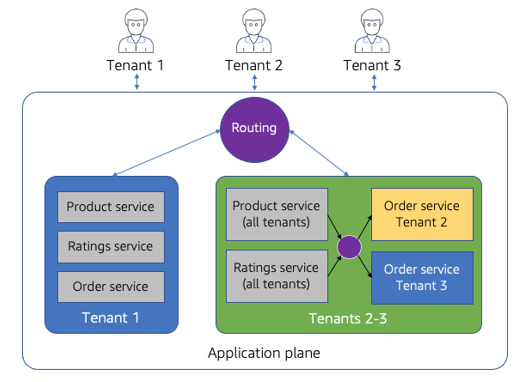Tenant Routing
In this simplest of SaaS architecture models, you may find that all tenants are sharing their resources. However, in most cases, your architecture is going to have variations where some or all of your tenant’s infrastructure may be dedicated. In fact, it would not be uncommon to have microservices that are deployed on a per tenant basis.
The main point here is that SaaS application architectures are often required to support a distributed footprint that has any number of resources running in a combination of shared and dedicated models. The image in Figure 2-8 provides a simplified sample of a SaaS architecture that supports a mix of shared and dedicated tenant resources.

Figure 2-8. Routing on tenant context
In this example, we have three tenants that will be making requests to invoke operations on our application services. In this particular example, we have some resources that are shared and some that are dedicated. On the left, tenant 1 has an entirely dedicated set of services. Meanwhile, on the right-hand side, you’ll see that we have the services that are being used by tenants 2 and 3. Here, note that we have the product and rating services that are being shared by both of these tenants. However, these tenants each have dedicated instances of the order service.
Now, as you step back and look at the overall configuration of these services, you can see where our multi-tenant architecture would need to include strategies and constructs that would correctly route tenant requests to the appropriate services. This happens at two levels within this example. If you start at the top of our application plane where our application plane is receiving requests from three separate tenants, you’ll notice that there’s a conceptual placeholder for a router here. This router must accept requests from all tenants and use the injected tenant context (that we discussed earlier) to determine how and where to route each request. Also, within the tenant 2/3 box on the right, you’ll see that there is another placeholder for routing that will determine which instance of the order service will receive requests (based on tenant context).
Let’s look at a couple concrete examples to sort this out. Suppose we get a request from tenant 1 to look up a product. When the router receives this request, it will examine the tenant context and route the traffic to the product service on the left (for tenant 1). Now, let’s say we get a request from tenant 3 to update a product that must also update an order. In this scenario, the top-level router would send the request to the shared product service on the right (based on the tenant 2 context). Then, the product service would send a request to the order service via the service-to-service router. This router would look at the tenant context, resolve it to tenant 2, and send a request to the order service that’s dedicated to tenant 2.
This example is meant to highlight the need for multi-tenant aware routing constructs that can handle the various deployments footprint we might have in a SaaS environment. Naturally, the technology and strategy that you apply here will vary based on a number of parameters. There are also a rich collection of routing tools and technologies, each of which might approach this differently. Often, this comes down to finding a tool that provides flexible and efficient ways to acquire and dynamically route traffic based on tenant context.
We’ll see these routing constructs applied in specific solutions later in this book. At this stage, it’s just important to understand that routing in multi-tenant environments often adds a new wrinkle to our infrastructure routing model.
Multi-Tenant Application Deployment
Deployment is a pretty well understood topic. Every application you build will require some DevOps technology and tooling that can deploy the initial version of your application and any subsequent updates. While these same concepts apply to the application plane of our multi-tenant environment, you’ll also discover that different flavors of tenant application models will add new considerations to your application deployment model.
We’ve already noted here that tenants may have a mix of dedicated and shared resources. Some may have fully dedicated resources, some may have fully shared, and others may have some mix of dedicated and shared. Knowing this, we have to now consider how this will influence the DevOps implementation of our application deployment.
Imagine deploying an application that had two dedicated microservices and three shared microservices. In this model, our deployment automation code will have to have some visibility into the multi-tenant configuration of our SaaS application. It won’t just deploy updated services like you would in a classic environment. It will need to consult the tenant deployment profile and determine which tenants might need a separate deployment of a microservice for each dedicated microservice. So, microservices within our application plane might be deployed multiple times. That, and our infrastructure automation code may need to apply tenant context to the configuration and security profile of each of these microservices.
Technically, this is not directly part of the application plane. However, it has a tight connection to the design and strategies we apply within the application plane. In general, you’ll find that the application plane and the provisioning of tenant environments will end up being very inter-connected.